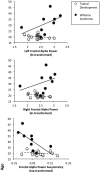Frontal asymmetry index in Williams syndrome: Evidence for altered emotional brain circuitry?
- PMID: 25633341
- PMCID: PMC4426071
- DOI: 10.1080/17470919.2015.1005667
Frontal asymmetry index in Williams syndrome: Evidence for altered emotional brain circuitry?
Abstract
Asymmetrical frontal electroencephalography (EEG) activity is associated with motivational neural systems of approach/withdrawal behaviors. Greater left frontal EEG has been linked to increased appetitive tendencies whereas increased right frontal activity is related to the activation of avoidance mechanisms. Williams syndrome (WS) is a genetic condition characterized by a highly sociable personality manifested by a propensity to approach strangers and decreased social fear. Consequently, the current study was designed to investigate the frontal cortical activity during resting state, indexed by relative alpha power, in adults with WS as compared to typically developing (TD) controls, and a subgroup of TD extraverts. Results indicated that participants with WS produced attenuated left frontal activity relative to TD peers, or TD extraverts in particular; yet, no groups differed in their degree of right frontal activity. Finally, while both TD group and the extravert subset showed trends of greater left over right frontal activity, the WS participants demonstrated opposing effect of increased right over left frontal EEG. Importantly, individuals with WS produced deviating frontal activity patterns compared to TD extraverts despite exhibiting common social-affiliative tendencies, underscoring that neural mechanisms that give rise to extraversion in WS may not function similarly to those subserving this personality trait expressed in TD.
Keywords: Alpha power; Extraversion; Resting EEG; Social neuroscience; Williams syndrome.
Figures



Similar articles
-
The influence of frontal alpha-asymmetry on the processing of approach- and withdrawal-related stimuli-A multichannel psychophysiology study.Psychophysiology. 2017 Sep;54(9):1295-1310. doi: 10.1111/psyp.12878. Epub 2017 Apr 26. Psychophysiology. 2017. PMID: 28444963
-
Effects of positive emotion, extraversion, and dopamine on cognitive stability-flexibility and frontal EEG asymmetry.Psychophysiology. 2018 Jan;55(1). doi: 10.1111/psyp.12727. Epub 2017 Mar 17. Psychophysiology. 2018. PMID: 28306164
-
Right-frontal cortical asymmetry predicts increased proneness to nostalgia.Psychophysiology. 2015 Aug;52(8):990-6. doi: 10.1111/psyp.12438. Epub 2015 Apr 16. Psychophysiology. 2015. PMID: 25877718
-
Asymmetrical frontal cortical activity associated with differential risk for mood and anxiety disorder symptoms: An RDoC perspective.Int J Psychophysiol. 2015 Nov;98(2 Pt 2):249-261. doi: 10.1016/j.ijpsycho.2015.06.004. Epub 2015 Jun 20. Int J Psychophysiol. 2015. PMID: 26100073 Review.
-
Regulatory behavior and frontal activity: Considering the role of revised-BIS in relative right frontal asymmetry.Psychophysiology. 2018 Jan;55(1). doi: 10.1111/psyp.12910. Epub 2017 Jul 4. Psychophysiology. 2018. PMID: 28675440 Review.
Cited by
-
An EEG investigation of alpha and beta activity during resting states in adults with Williams syndrome.BMC Psychol. 2021 May 5;9(1):72. doi: 10.1186/s40359-021-00575-w. BMC Psychol. 2021. PMID: 33952354 Free PMC article.
-
Comparison of the Effectiveness of Transcranial Direct Current Stimulation (tDCS) and Short-Term Cognitive Rehabilitation Protocols on the Improvement of Depression and Anxiety Symptoms in Patients With Mild Alzheimer's Disease.J Aging Res. 2025 Jul 29;2025:6616509. doi: 10.1155/jare/6616509. eCollection 2025. J Aging Res. 2025. PMID: 40765731 Free PMC article.
-
Electroencephalographic Signature of Negative Self Perceptions in Medical Students.Cureus. 2022 Feb 28;14(2):e22675. doi: 10.7759/cureus.22675. eCollection 2022 Feb. Cureus. 2022. PMID: 35242485 Free PMC article.
References
-
- Carver CS, White TL. Behavioral inhibition, behavioral activation, and affective responses to impending reward and punishment: The BIS/BAS scales. Journal of Personality and Social Psychology. 1994;67(2):319–333.
-
- Coan JA, Allen JJ. Frontal EEG asymmetry and the behavioral activation and inhibition systems. Psychophysiology. 2003;40(1):106–114. - PubMed
-
- Coan JA, Allen JJ. Frontal EEG asymmetry as a moderator and mediator of emotion. Biological Psychology. 2004;67(1):7–50. - PubMed
-
- Costa PT, McCrae RR. Professional manual: revised NEO personality inventory (NEO-PI-R) and NEO five-factor inventory (NEO-FFI) Psychological Assessment Resources; Odessa, FL: 1992.
Publication types
MeSH terms
Grants and funding
LinkOut - more resources
Full Text Sources
Other Literature Sources
